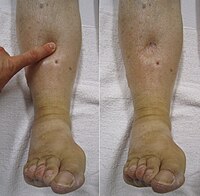
Photo from wikipedia
Importance Systemic blood flow alterations have been described using video nailfold capillaroscopy (NFC) in high-tension glaucoma (HTG) and normal-tension glaucoma (NTG) variants of primary open-angle glaucoma (POAG). To date, no… Click to show full abstract
Importance Systemic blood flow alterations have been described using video nailfold capillaroscopy (NFC) in high-tension glaucoma (HTG) and normal-tension glaucoma (NTG) variants of primary open-angle glaucoma (POAG). To date, no previous studies have explored alterations in nailfold capillary blood flow in exfoliation glaucoma (XFG). Objective To investigate the measure of peripheral blood flow as a surrogate marker of systemic vascular involvement in patients with XFG, HTG, and NTG, as well as in individuals serving as controls, using NFC. Design, Setting, and Participants A cross-sectional clinic-based study at the New York Eye and Ear Infirmary of Mount Sinai was conducted from July 6, 2017, to May 18, 2018. A total of 111 participants (30 XFG, 30 NTG, 30 HTG, and 21 controls) received a comprehensive ophthalmic examination to confirm eligibility. Exclusion criteria were the presence of connective tissue disease, uncontrolled diabetes, history of bleeding disorders, and/or history of trauma or surgery to the nondominant hand. Main Outcomes and Measures Resting capillary blood flow at the nailfold of the fourth digit of the nondominant hand in patients with NTG, HTG, XFG, and controls, using NFC. Results Two participants were excluded owing to poor nailfold image quality, resulting in 109 participants. Sixty-two participants (57%) were women and 79 (72%) were white. Mean (SD) age of the participants was 67.9 (11.7) years. Mean (SD) resting peripheral capillary blood flow at the nailfold for controls was 70.9 (52.4) picoliters/s (pL/s); HTG, 47.5 (41.9) pL/s; NTG, 40.1 (16.6) pL/s; and XFG, 30.6 (20.0) pL/s. Multivariable analysis of the differences of flow in HTG vs control participants showed values of -18.97 (95% CI, -39.22 to 1.27; P = .07) pL/s, NTG vs controls of -25.17 (95% CI, -45.92 to -4.41; P = .02) pL/s, and XFG vs controls of -28.99 (95% CI, -51.35 to -6.63; P = .01) pL/s. Conclusions and Relevance Decreased resting peripheral capillary blood flow may occur in patients with XFG and NTG compared with individuals without glaucoma. These findings may contribute to understanding the possible systemic nature of glaucoma.
Journal Title: JAMA ophthalmology
Year Published: 2019
Link to full text (if available)
Share on Social Media: Sign Up to like & get
recommendations!